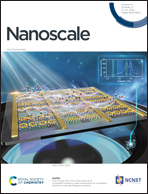Surface modification of carbon nitride dots by nanoarchitectonics for better drug loading and higher cancer selectivity†
Abstract
Carbon Dots (CDs) have recently attracted a considerable amount of attention thanks to their well-documented biocompatibility, tunable photoluminescence, and excellent water solubility. However, CDs need further analysis before their potential use in clinical trials. Previously, we reported a new type of carbon nitride dot (CND) that displayed selective cancer uptake traits attributed to structural resemblances between CNDs and glutamine. Here, the effects of surface structural differences on the cellular uptake of CNDs are further investigated to understand their selective cancer cell uptake trend. Beyond enhanced drug loading on modified CNDs, our cytotoxicity, western blotting and bioimaging studies proposed that modified CNDs’ cellular uptake mechanism is thoroughly linked with ASCT2 and LAT1 transporters. Therefore, CNDs have a promising trait of selective cancer cell targeting by utilizing highly expressed transporters on cancer cells. Additionally, drug loaded CNDs exhibited improved anti-cancer efficacies towards cancer cells along with good non-tumor biocompatibilities.



 Please wait while we load your content...
Please wait while we load your content...